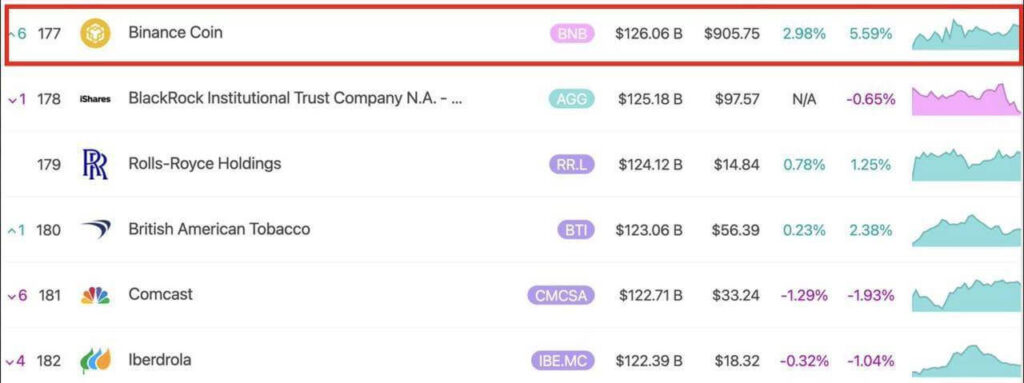BNB (Binance Coin) surged to a record $904.37, pushing its market capitalization above $124 billion and vaulting it into the fifth-largest cryptocurrency by market cap. The rally followed strong technical momentum and an institutional partnership that renewed investor confidence in BNB’s ecosystem growth.
-
BNB set a new all-time high of $904.37 and topped a $124B market cap, surpassing Solana.
-
Institutional momentum from a Binance–Franklin Templeton collaboration boosted confidence and flows.
-
Market data showed BNB at roughly $124.67B market cap on September 10, 2025, ranking fifth among cryptocurrencies.
BNB hits $904 and $124B market cap — Binance Coin soars to fifth-largest crypto after institutional deal; read analysis and key takeaways.
What caused BNB to hit $904 and a $124B market cap?
BNB surged after a mix of strong technical momentum and an institutional partnership announcement, driving demand and liquidity into the token. The price reached $904.37 on September 10, 2025, lifting market capitalization above $124 billion and moving BNB into the fifth-ranked crypto slot.
How did institutional partnership activity affect BNB’s price and market cap?
The announced collaboration between Binance and Franklin Templeton, an asset manager with approximately $1.6 trillion under management, signaled renewed institutional interest. Short-term trading flows and strategic tokenization initiatives were cited by market analysts as catalysts, increasing buy-side pressure and improving market sentiment.
Binance Coin (BNB) posted a notable rally this week, climbing past a $124 billion market capitalization and overtaking Solana in coin rankings. The token now sits behind Bitcoin, Ethereum, Tether and XRP in the global cryptocurrency standings.
Official updates reported that BNB reached an all-time high of $904.37 on September 10, 2025. The breakout followed persistent upward trend behavior and fresh institutional attention tied to strategic collaborations.
Why does BNB’s ecosystem development matter for prices?
BNB’s price movements historically align with ecosystem milestones: protocol upgrades, cross-chain integrations, and strategic partnerships. These events tend to expand utility and on-chain activity, which in turn supports sustained demand for the token.
Cross-chain activity between Binance Smart Chain and networks such as Ethereum and Avalanche correlated with higher trading volumes in recent quarters. Binance’s leadership emphasized the partnership angle as a structural growth factor rather than pure competition.

How does BNB compare to other crypto assets and companies?
BNB’s newfound market capitalization places it above several notable corporate valuations and ahead of certain blockchains in market ranking. This reflects the token’s expanded role within the Binance ecosystem and rising institutional interest.
| Metric | BNB (Sep 10, 2025) | Notes |
|---|---|---|
| Price (ATH) | $904.37 | New all-time high recorded on Sep 10, 2025 |
| Market Cap | ~$124.67B | Elevated to 5th-largest cryptocurrency by market cap |
| Ranking | 5 | Behind BTC, ETH, USDT, XRP |
Frequently Asked Questions
Did BNB overtake Solana in market capitalization?
Yes. Market data placed BNB’s capitalization above Solana’s level during the September 2025 rally, moving Binance Coin into the fifth slot among cryptocurrencies by market cap.
What role did Franklin Templeton play in the BNB surge?
Franklin Templeton’s collaboration with Binance was highlighted as a catalyst that reinforced institutional interest. The partnership focuses on tokenization initiatives and leveraged Franklin Templeton’s $1.6 trillion asset management expertise.
Key Takeaways
- Record high: BNB reached $904.37 with a market cap north of $124B.
- Institutional momentum: The Binance–Franklin Templeton collaboration lifted investor confidence.
- Ecosystem impact: Ongoing BSC development and cross-chain activity supported the rally; monitor on-chain metrics for continuation signals.
Conclusion
The BNB rally to $904 and a ~$124.67B market cap underscores growing institutional engagement and sustained ecosystem expansion. Continued on-chain adoption and strategic partnerships will be key indicators to watch; investors should monitor liquidity and developer activity for signals of long-term strength.
